Parrots are a colorful and diverse type of bird, with more than 350 known species living today. Most parrots live in tropical environments, but some species, like keas, live in alpine regions. While birds are known for their intelligence, parrots are especially smart and have excellent memories.
One of the parrot’s most notable traits is its ability to copy human speech. A parrot can memorize more than 150 words and phrases, but experts aren’t sure that these birds understand what they’re saying. Macaws and African parrots are some of the most talkative parrot species.
Parrots can be excellent companions and are popular pets. However, since parrots are very social, it’s best to keep birds in pairs.
Many parrot species have a very long lifespan, and it’s not unusual for a pet parrot to outlive its owner. One green-winged macaw has lived for more than 90 years!
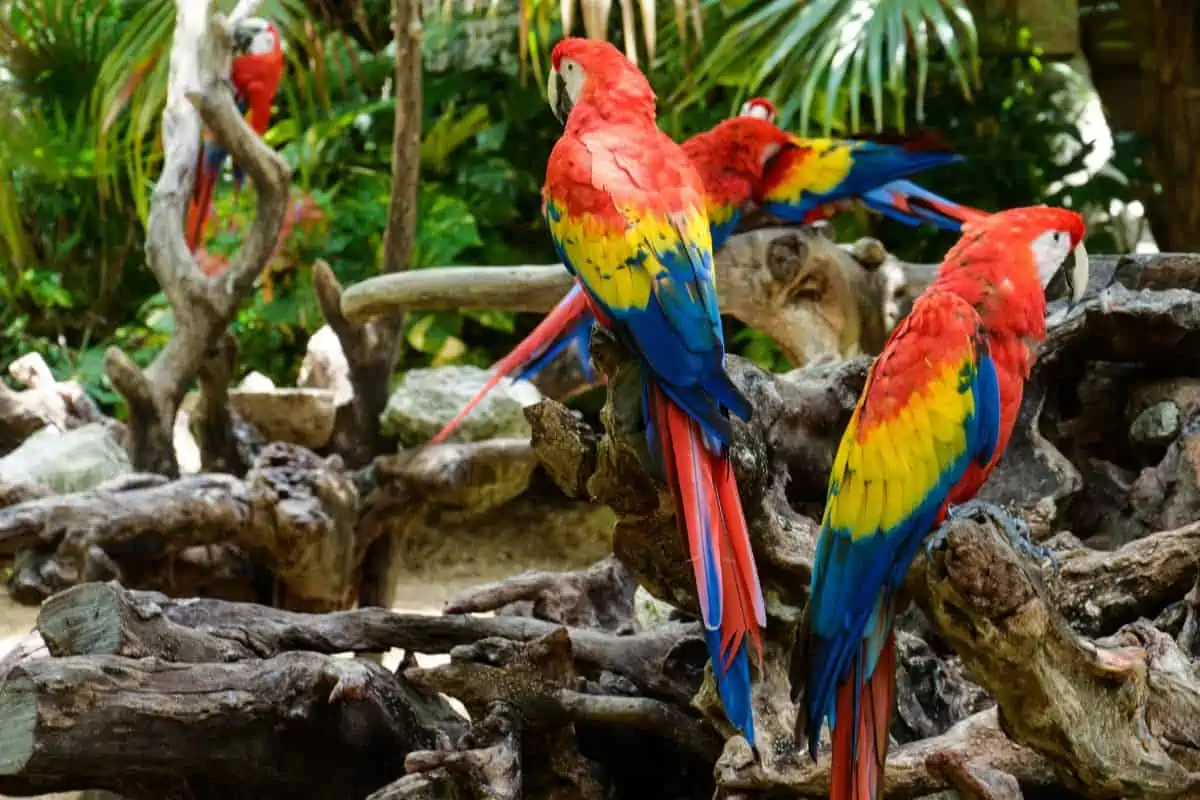
15 Birds Like Parrots
There are hundreds of different parrot species, but most parrots share certain traits, such as colorful feathers, human-like vocalizations, and a high level of intelligence. These 15 birds aren’t a part of the parrot family, but they’re similar to parrots in a number of ways.
1. Birds of paradise
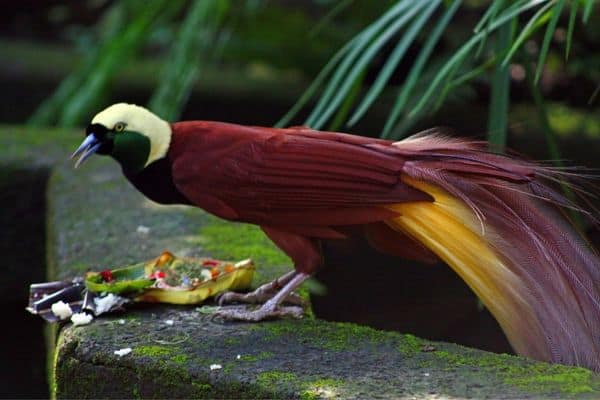
Why birds of paradise are like parrots: Both birds are known for their brightly-colored feathers and are a favorite of birdwatchers
There are 44 species of birds-of-paradise, and nearly all of these worlds have beautiful and colorful feathers like parrots do. Most birds-of-paradise live in tropical forests, where they eat a diet of fruit and insects.
While the size of these birds can vary based on the species, some birds can grow up to 16 inches long. Male birds will often behave strangely when trying to attract mates.
2. Mynah Birds
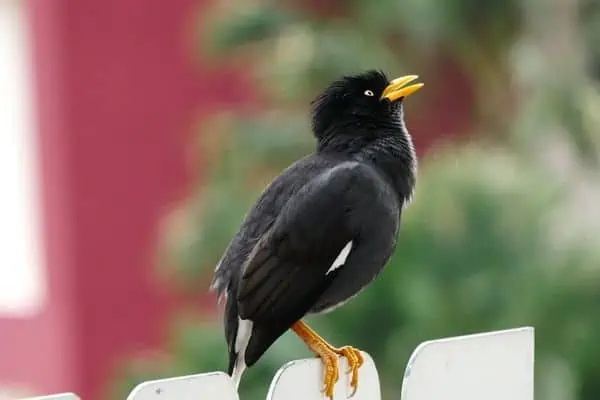
Why mynah birds are like parrots: Similar to parrots, mynah birds are known for their ability to mimic human speech
While parrots are famous for their ability to talk, mynah birds are one of the best human mimics in the animal kingdom! Thanks to their flexible tongues, they’re able to copy all kinds of sounds, including human vowels.
The mynah bird lives in tropical habitats and is very territorial. It mostly dines on fruits and vegetables, but it’s an omnivore that’s willing to eat almost anything.
3. Falcons
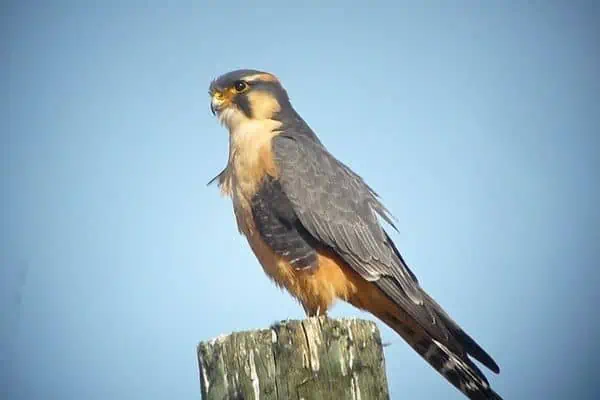
Why falcons are like parrots: Falcons are frequently compared to hawks, but the parrot is one of its closest relatives
While experts once assumed that the falcon was a relative of the hawk, new research actually shows that falcons are closer to parrots than other hunting birds!
Unlike parrots, falcons are carnivores, but both birds have short curved beaks that help them catch prey. Peregrine falcons for instance are incredibly fast when in flight and can reach speeds over 200 miles per hour. Also like parrots, many falcons mate for life.
4. Jays
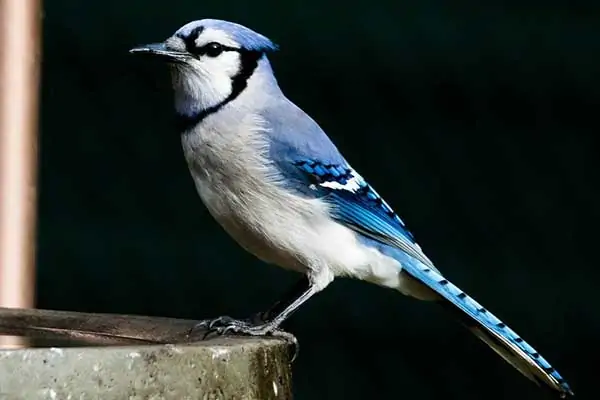
Why jays are like parrots: Parrots and jays are both energetic, colorful birds that are known for their intelligence
Jays are a noisy bird that’s a part of the corvid family. While these birds can’t mimic human speech, they can imitate the calls of other animals, which helps them to trick predators. Some jays can even use tools in order to reach food. Many jay species have brightly-colored blue feathers.
5. Magpies
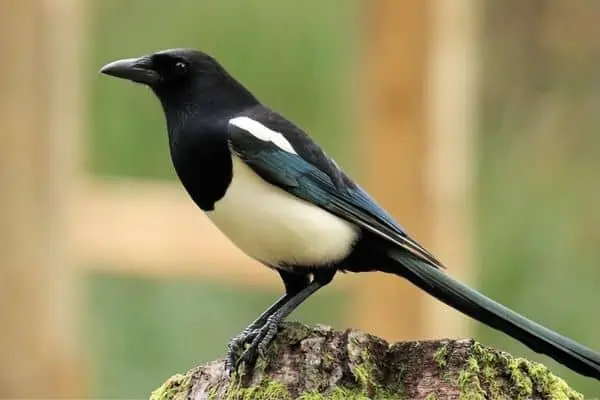
Why magpies are like parrots: Magpies are famous for being songbirds, but they can also copy human speech!
Magpies and parrots are both omnivores, but a magpie tends to change its diet with the seasons. In the winter, magpies feed on berries, but in the summer, they mostly eat insects. Like parrots, magpies can mimic human sounds, and they imitate sounds made by other animals as well.
Some birds are drawn to shiny objects, but magpies are actually afraid of items that shine!
6. Kingfishers
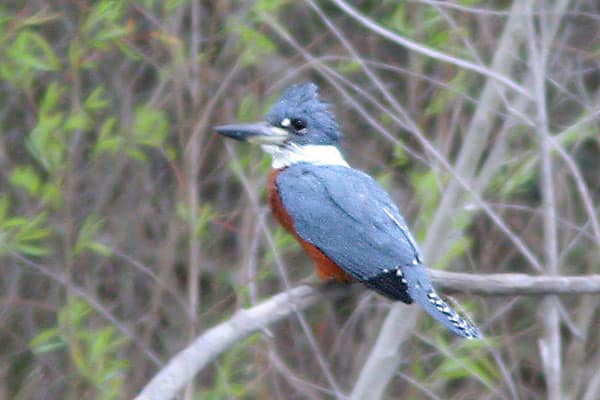
Why kingfishers are like parrots: Both birds have bright, colorful feathers and are usually found in tropical environments
There are 87 known species of kingfisher, and nearly all of these birds have bold, bright plumage. Kingfisher are usually found in wooded tropical areas, but they also live in some parts of Europe.
The largest kingfisher species is the kookaburra, which can grow up to 19 inches. In spite of its name, many kingfishers don’t eat fish and dine on plants and insects instead.
7. Ravens

Why ravens are like parrots: Ravens and parrots are some of the most intelligent birds living today
Ravens are large birds with all-black feathers. Although ravens aren’t colorful like parrots are, they’re a match for parrots when it comes to intelligence!
Ravens can use tools and are able to mimic a variety of noises, including animal calls, car engines, and even human speech. Parrots and ravens are among the only bird species that have been seeing playing with each other in the wild.
8. Canaries
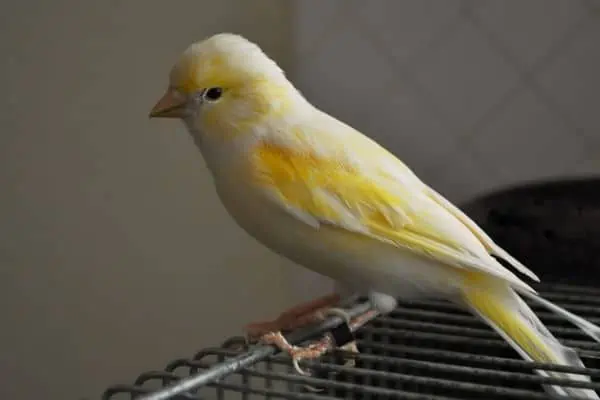
Why canaries are like parrots: Like parrots, canaries are popular pets that imitate the sounds humans make
Canaries don’t talk the way that humans do, but pet canaries can copy humans and create language-like songs. Since canaries use their songs to attract mates, male canaries are better at singing than females are.
Many canaries have bright yellow feathers, but canaries can be found in many other colors, including orange, pink, and brown. While canaries make excellent pets, they’re happiest in a large cage where they have room to fly.
9. Shrikes

Why shrikes are like parrots: Parrots and shrikes both have curved beaks that help them catch and eat prey
Shrikes are songbirds, but they’re also excellent hunters that feed on insects, mice, and even smaller birds. Unlike parrots, shrikes are carnivores, but these birds have a very similar beak shape. Like parrots, shrikes form monogamous pairs and tend to be very social.
Shrikes are very intelligent and can even kill prey by dropping it on branches or barbed wire.
10. Rainbow Finches
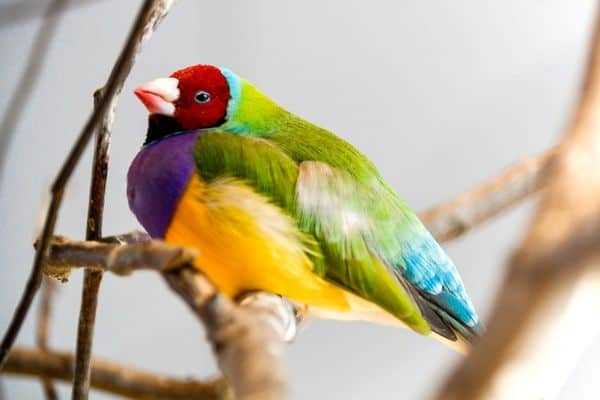
Why rainbow finches are like parrots: These bright finches have colorful feathers and short curved beaks like parrots do
While some finches have brown feathers, rainbow finches look like they could be parrots! True to its name, this bird’s plumage includes all the colors of the rainbow, with red, yellow, turquoise, and green patches.
Rainbow finches are tropical birds and are most comfortable in temperatures above 80 degrees. They are herbivores and mostly feed on grass seeds.
11. Mockingbirds
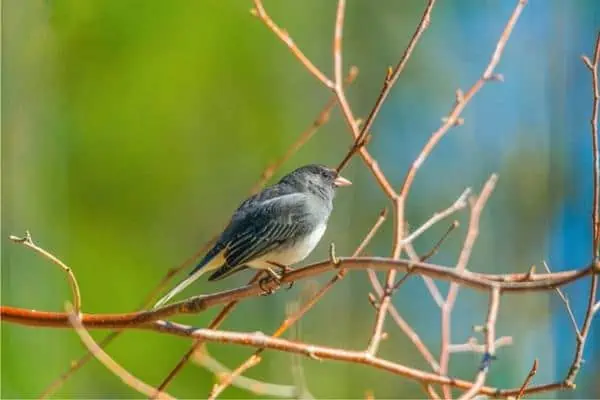
Why mockingbirds are like parrots: Mockingbirds can learn hundreds of songs and can even imitate human speech!
Just like parrots, mockingbirds are amazing imitators. In Latin, the mockingbird is called “mimus polyglottos,” which means “multi-tongued mimic.” Not only do mockingbirds mimic the calls of other animals, but they also copy other sounds in their environment, including the sound of machinery.
While mockingbirds can’t copy human speech as well as a parrot can, it is able to learn words when it spends time around humans.
12. Puffins
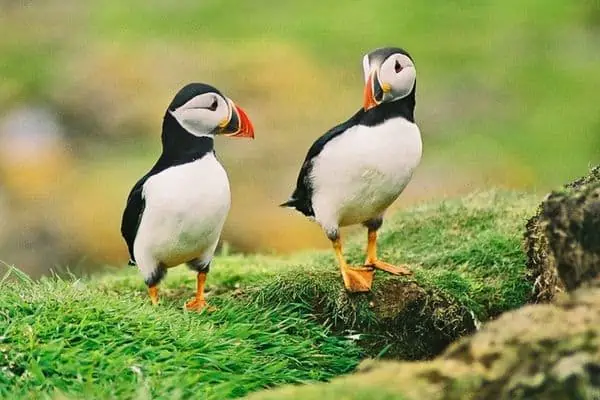
Why puffins are like parrots: Puffins have short, curved beaks and mate for life like parrots do
Puffins resemble parrots and have even earned the nickname “sea parrot.” The puffin spends most of its time in and on the water, swimming and resting on waves. It has a curved beak that changes colors depending on the season, going from a plain shade of gray to a bright orange!
Puffins are carnivores and like to eat small fish, such as herring, sand lance, and hake.
13. Lyrebirds
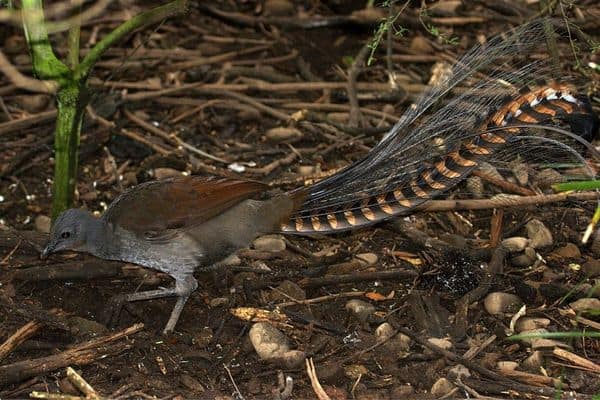
Why lyrebirds are like parrots: Both birds can copy all kinds of sounds, including human voices
The lyrebird is an unusual-looking bird that’s native to Australia. Males have a long and ornate tail with beautiful curved feathers, while females have a long tail that’s less elaborate. Lyrebirds are great mimics and will copy all kinds of sounds, including the sounds of car alarms and camera shutters!
The lyrebird also enjoys decorating and will use feathers and other objects that it finds that it finds to make a beautiful home.
14. Hummingbirds
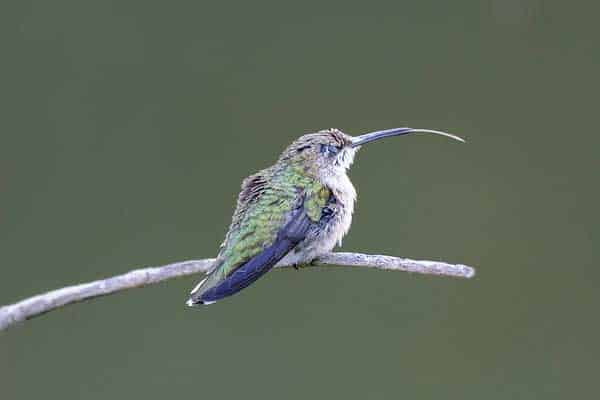
Why hummingbirds are like parrots: Both birds are omnivores and have very colorful feathers
Hummingbirds are fast, tiny birds that travel more than 60 miles per hour and usually measure between 3 and 4 inches. While hummingbirds are tiny compared to parrots, both birds have bold-colored plumage and excellent memories.
Some recent research even suggests that the hummingbird may have an episodic memory! There are 340 living species of hummingbird, with all species living in North or South America.
15. Starlings
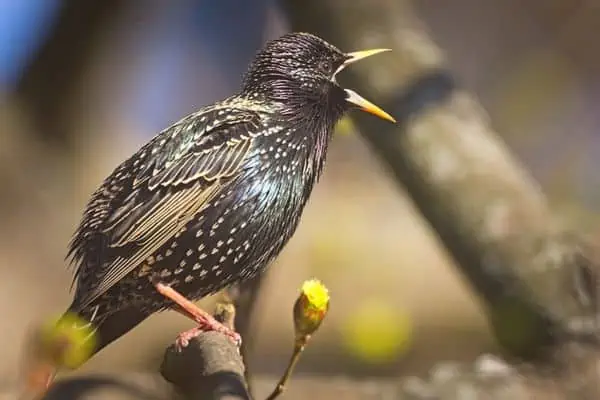
Why starlings are like parrots: Starlings are passerines and are close relatives of parrots
The starling is a type of passerine, which is the order of bird most closely related to the parrot. From a distance, a starling might look like it has black feathers, but when you see it close up, you’ll notice very bright colors, including shades of purple and green. Starlings are omnivores and usually adapt their diet to the season.
The starling is an intelligent and vocal bird that uses its songs to communicate with other birds.





